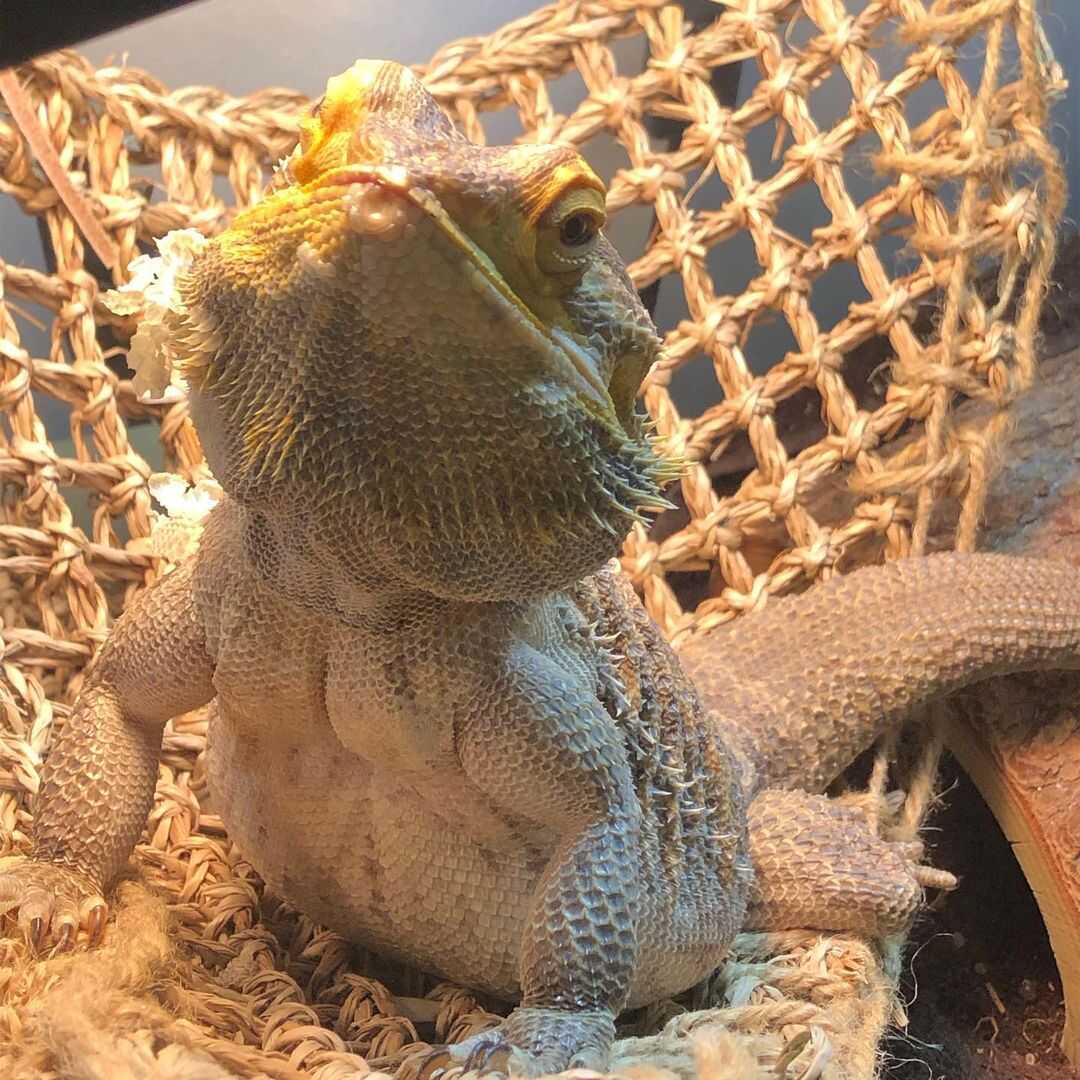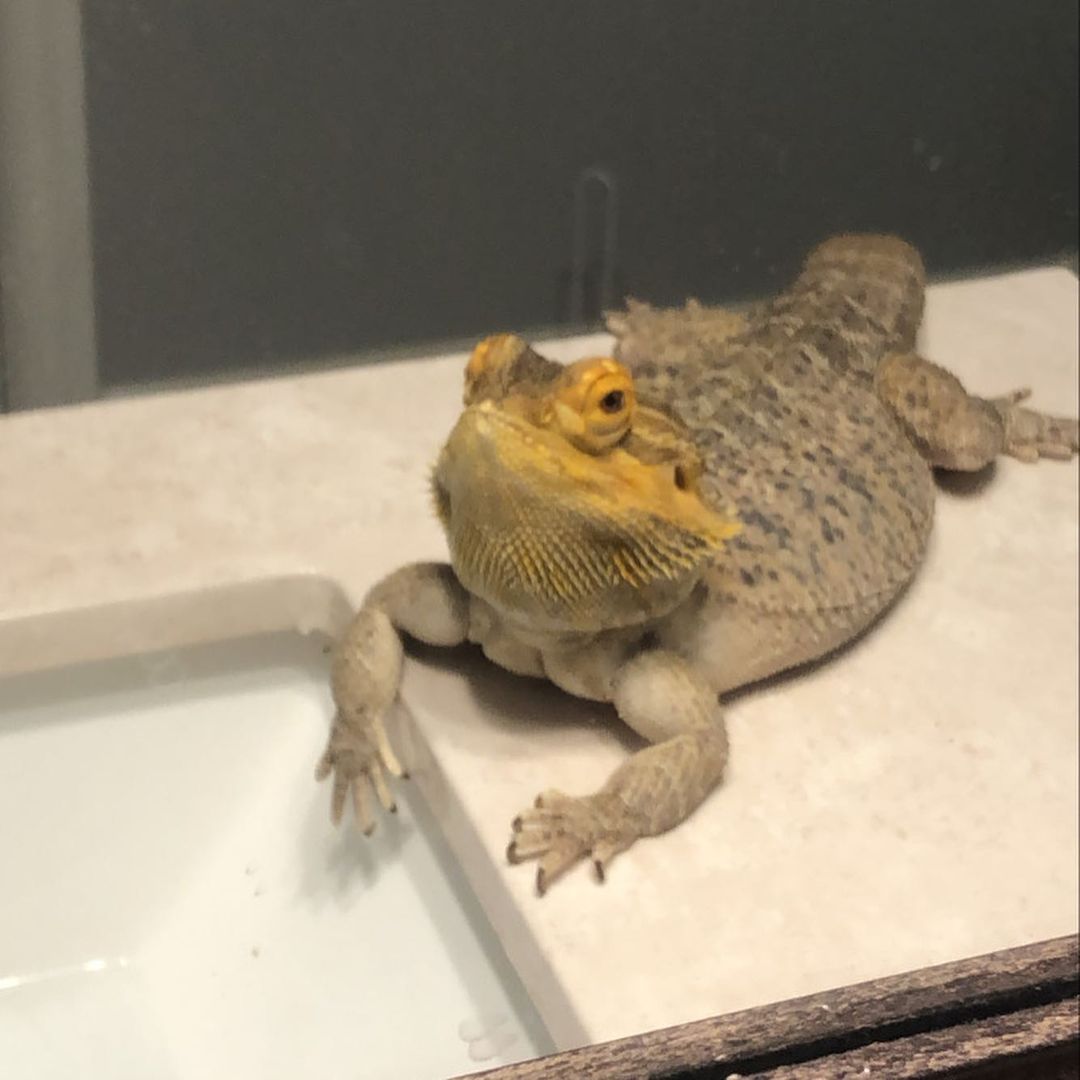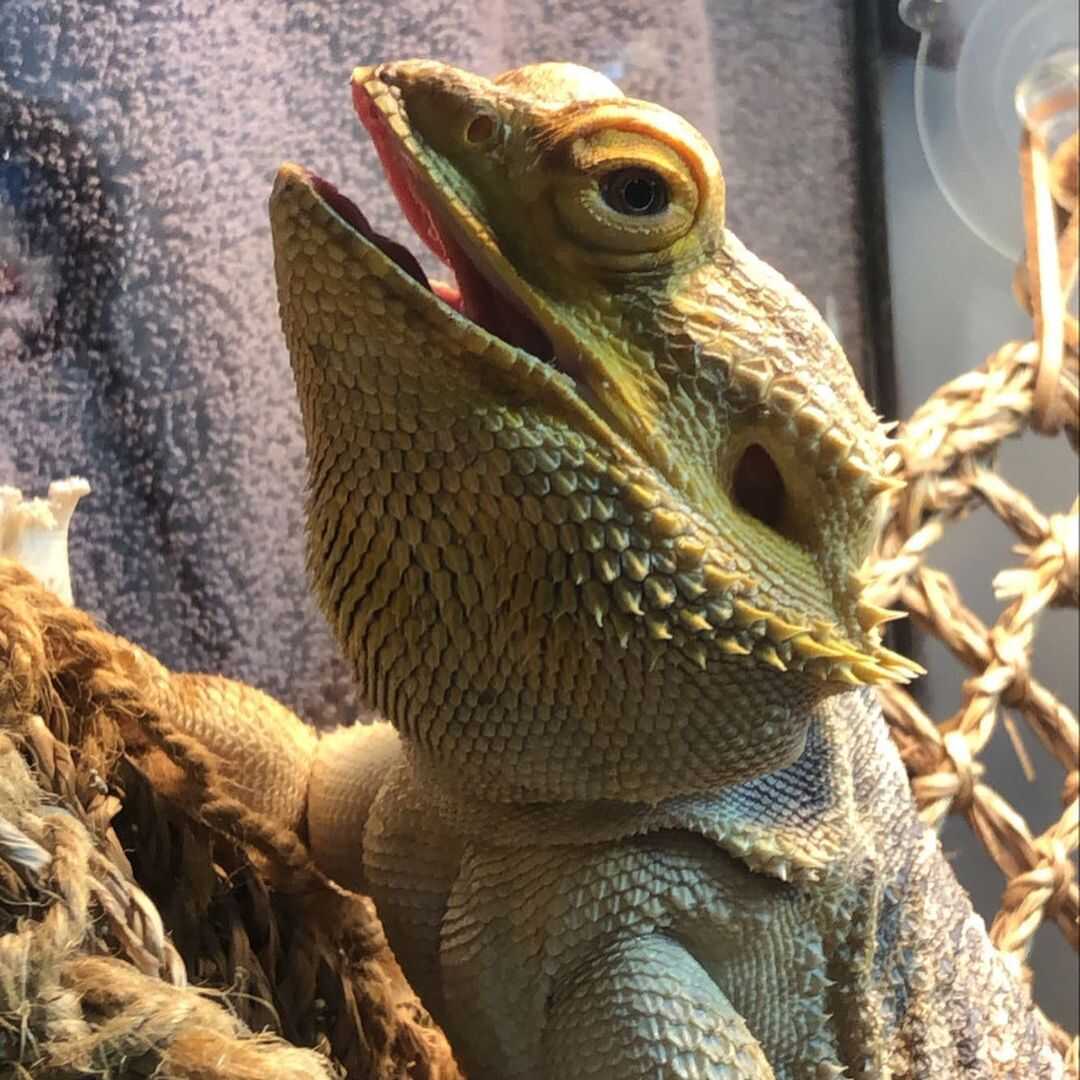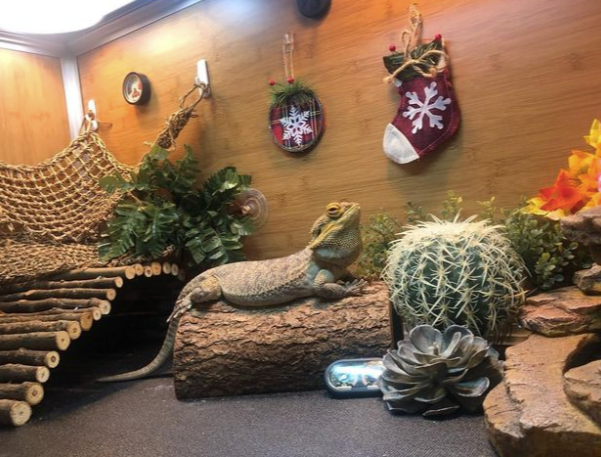Step into the enchanting world of bearded dragons!
These captivating creatures have a secret language that will leave you in awe.
Forget barks and meows—bearded dragons communicate through non-verbal cues in a truly unique way.
Cracking the code of their body language unlocks a treasure trove of understanding.
And it all starts with the enigmatic puffed up pose, holding countless wonders waiting to be discovered.
Prepare to be captivated by the hidden world of bearded dragon communication!
Let’s dive in!
Table of Contents
Understanding and Overview of the Puffed Up Pose

The Puffed up pose is a common sight for bearded dragon owners. When a bearded dragon puffs up, it inflates its body and beard, making it look larger and more intimidating.
This display can be quite dramatic if you see it for the first time. But this pose holds significant meaning in their behavior repertoire.
Bearded dragons puff up for a range of reasons. It could be a sign of stress, a response to a perceived threat, or even a part of their mating ritual. Observing their environment and accompanying behaviors is the key to interpreting this pose.
Recognizing the puffed up pose can help you better understand your bearded dragon’s emotions. It lets you quickly respond to your bearded dragon’s needs to improve their comfort and health.
5 Most Common Reasons Why Bearded Dragon Puffs Up
When your bearded dragon puffs up, it’s not just a random occurrence. Oh no! It’s a clue, a little hint about their emotional and physiological state. It’s like they’re trying to communicate with us using their inflatable body language. How cool is that?
So, get ready to unravel the mystery as we delve into the 5 most common reasons behind their magnificent puffing displays. We’ll help you decode their signals and gain a deeper understanding of your scaly friend.
Let’s start this exciting adventure together!
Defensive and Protective
When it comes to a bearded dragon’s well-being, they resort to various signals and tactics. Puffing up is one of them.
Aggression
Bearded dragons sometimes puff up when they are feeling aggressive. This is a display of dominance, and they may also darken their beard as a show of power.
If your bearded dragon puffs up and shows a darkened beard, it’s telling you it’s in an aggressive mood.
Defense Mechanism
Puffing up can also be a defense mechanism. In the wild, a bearded dragon puffs up to look bigger and more intimidating to potential predators. Domesticated dragons can also exhibit this behavior.
When they feel threatened or perceive danger, they puff up to appear more formidable and discourage potential threats.
Feeling Cornered
In situations where a bearded dragon feels cornered, it puffs up. This is their way of trying to escape a tight spot. It’s a signal they’re uncomfortable and want more space.
By puffing up, they hope to create enough visual barriers to ward off any perceived threat and create an opportunity for escape.
Intimidation
The act of puffing up is a strategic move to intimidate. A bearded dragon puffs up to present itself as a formidable opponent. Essentially, it’s their way of saying, “Think twice before messing with me.”
This behavior is often accompanied by other displays of aggression, such as head bobbing or tail arching, to establish dominance and discourage any potential challengers.
Territorial and Dominance
Like many species, bearded dragons also have a keen sense of territory and dominance, which influence their puffing behavior.
Territory Assertion
Bearded dragons are notably territorial. They can puff up to assert their territory. They expand their bodies to appear more commanding, telling other dragons, “This is my space!”
This behavior is particularly common when introducing a new dragon to an established group or when two dragons compete for dominance within a shared space.
Communication With Other Dragons
Just as we use body language to communicate, so do bearded dragons. When they puff up, it’s their way of conveying messages to other dragons. It can mean anything from asserting dominance to telling others to stay away from their territory.
By puffing up, they establish boundaries and communicate their intentions to other dragons, avoiding unnecessary conflicts and maintaining social order within their group.
Establishing Boundaries
Puffing up helps establish boundaries. This behavior is important in maintaining peace among bearded dragons in shared spaces. When a dragon puffs up, it’s not just being sassy; it’s laying down the law.
Bearded dragons can coexist peacefully by clearly defining their personal space and reducing the potential issues due to territorial disputes.
Reproductive and Courtship
Puffing up isn’t just about conflict or stress. It’s also integral to bearded dragons’ courtship and reproductive behaviors.
Mating Behavior
During mating season, a male bearded dragon puffs up to attract a mate. This puffing displays his masculinity and health, making him more attractive to potential mates. By expanding their bodies and puffing up, males aim to impress females and signal their readiness for breeding.
This behavior is often accompanied by head bobbing, arm waving, and other courtship displays to woo a female successfully.
Courtship Display / Boosting Self-Confidence
In addition to attracting a mate, puffing up can boost a dragon’s self-confidence during courtship. It improves their visual presence, making them appear more dominant and confident.
It’s a way for them to make a lasting impression on their potential partners and increase their chances of successful courtship.
Stress and Discomfort
A bearded dragon’s puffing behavior can also be a sign of stress or discomfort for various reasons.
Environmental Stress
Changes in their environment can cause stress to a bearded dragon. Puffing up can show their discomfort with these changes. Examples could include a sudden change in temperature, exposure to loud noises, or even introducing new objects or decor in their habitat.
Bearded dragons are creatures of habit, and any disruption to their familiar surroundings can lead to stress, resulting in puffing up as a visible sign of their unease.
Inadequate Enclosure Size
Creating a spacious and comfortable home for your bearded dragon is absolutely vital for their overall well-being. Picture it like a dragon kingdom where they can freely roam, stretch their scaly limbs, and indulge in their natural behaviors.
A roomy enclosure not only keeps them physically healthy but also helps them feel secure and at ease in their own scaled sanctuary.
Insecure or Nervous
Feeling insecure or nervous can also lead to puffing. A new environment or the presence of a new pet or person can induce such feelings. Puffing up is their way of coping, a form of self-soothing to make themselves feel more secure.
Giving them time to adjust to new surroundings or individuals gradually is important, allowing them to feel more confident and reduce their stress levels.
Health and Well-being
Sometimes, puffing up can be a sign of health issues. It’s crucial to be mindful of this behavior as it might signal a need for medical attention.
Illness or Injury
A sick or injured bearded dragon might puff up as a response to pain or discomfort. In these cases, getting them checked by a reptile veterinarian to diagnose the issue and start appropriate treatment is essential.
Puffing up accompanied by lethargy, loss of appetite, or other concerning symptoms can be a red flag indicating an underlying health problem that requires professional attention.
Reactions to External Factors
Bearded dragons are sensitive creatures that respond to their environment in various ways, including puffing up.
Stressful Interactions
Negative interactions, whether with humans or other animals, can cause stress to a bearded dragon, leading them to puff up. It’s vital to ensure they’re rarely exposed to such encounters and handle them with care and respect. Creating a secure and comfortable environment for your bearded dragon involves gentle, positive interactions that build trust.
Response to Noise or Sudden Movements
Loud noises or sudden movements can startle your bearded dragon, causing it to puff up. Maintaining a calm and stable environment can minimize these reactions and create a more comfortable space for your pet.
Keeping their habitat in a quiet area and avoiding sudden movements around them can contribute to their overall health and reduce unnecessary stress.
Understanding why your bearded dragon puffs up helps ensure they’re healthy, comfortable, and secure. It allows you to provide appropriate care, create a suitable environment, and build a strong bond with your scaly companion.
By recognizing the different reasons behind this behavior, you can respond appropriately and ensure the well-being of your beloved bearded dragon.
Different Variations of Puffing Up

Not all puffing up is the same—each variation tells a unique story, from subtle poofs to dramatic displays with extended beards. By understanding these signals, you’ll decipher your dragon’s behavior and respond to their needs more effectively.
Let’s explore these puffing displays and enhance our understanding of our scaly companions!
Puffing Up Without Black Beard
One of the peculiarities of bearded dragons is the behavior of puffing up without showcasing a black beard. When a bearded dragon puffs up without darkening its beard, it can be a simple stretch, a way to regulate body temperature, or even a way to increase its perceived size.
They’re flexing their body and beard, saying, “Look at me. I’m big and strong.” It’s usually mild behavior unless paired with signs of distress or sickness.
Puffing Up With The Beard Extended
An extended beard accompanying a puffed-up body is quite a sight! Bearded dragons do this mainly for two reasons – aggression and courtship.
Male dragons puff their beard out to look larger and more intimidating, especially when they sense a threat. This tactic also proves helpful in attracting females during the mating season.
If you see a bearded dragon puffing up with an extended beard, it’s either in fight or flight mode or is trying to win over a potential mate.
Puffing Up Without Simultaneous Flaring
Interestingly, puffing up only sometimes comes with simultaneous flaring. This could show various emotions or responses. Sometimes, it can be a simple stretching or a sign of relaxation. The dragon inflates its body without flaring out its beard or displaying aggressive behavior.
So, if your bearded dragon is puffed up but not flared, don’t worry. It’s just enjoying some stretching and relaxation! You need to understand their unique behaviors. Recognizing their body language and meeting their needs strengthens your bond and keeps them healthy.
Remember, each dragon is unique, so what’s normal for one might be different for another. Observe, learn, and grow together for a rewarding companionship.
Observing Puffed-Up and Flared-Bearded Dragons

Observing the behaviors of your bearded dragon offers an exciting window into their world. One of the most prominent displays you might notice is their puffing up. This isn’t just a random act but a meaningful expression carrying various possible implications.
But it’s crucial to understand what these displays signify. Let’s explore them.
Differentiating Puffing Up From Flaring And Their Combined Display
Puffing up and flaring might seem similar, but they’re not. Puffing up is a physical display, where a bearded dragon inflates its body and beard, while flaring involves spreading the beard outwards. These actions might occur together, signaling heightened agitation or aggression.
A puffed and flared bearded dragon is quite an impressive spectacle, but remember, it’s a clear signal that your pet is feeling defensive or territorial.
Understanding The Intensity And Duration Of The Displays
It’s also vital to note the intensity and duration of these displays. A brief puff or flare might be a momentary reaction to a startling noise or sudden movement. But, prolonged or repeated displays could indicate a persisting issue like discomfort, stress, or illness.
Observing the frequency and duration of these signs can provide valuable insights into your bearded dragon’s well-being.
Is There a Reason for Concern?
So, when should you be concerned? An occasional puff or flare is natural. But if these actions become frequent or persist, it’s time to investigate further. Constant flaring or puffing up could show stress, discomfort, or health problems.
If you notice these behaviors accompanied by other changes, such as reduced appetite, lethargy, or behavioral shifts, it’s best to consult with a vet.
As bearded dragon enthusiasts, understanding these signs is key to ensuring our scaly friends’ happiness and health. Each dragon is unique and will have unique ways of communicating with you. Be it a puff, a flare, or both, getting to know these signals will bring you closer to your pet.
Responding to a Puffed-Up or Flared-Bearded Dragon

Responding to a puffed-up or flared bearded dragon requires patience and understanding. Your immediate reaction might be a concern, but remember, it’s usually a form of communication.
Your pet isn’t trying to harm you. It’s trying to tell you something. Take your time handling your dragon if it’s puffed up or has a flared beard. It might interpret your actions as threatening, leading to stress or aggression.
Wait until it calms down. Once the dragon is relaxed, approach it gently. Use a soft voice and slow movements to avoid startling it. With patience, understanding, and gentle care, you can ensure your bearded dragon feels safe and comfortable.
Conclusion
Observing differences in puffing behavior in your bearded dragon can help you better understand their needs, whether they’re expressing stress, asserting territory, or indicating a potential health issue. You can reduce stressful behavior by maintaining a safe and peaceful environment.
If your reptile keeps puffing up and shows other signs of distress, contact a reptile vet immediately. Being watchful and responding instantly to their behavior ensures they stay healthy and live long lives.
You can build stronger bonds and care more effectively for their needs by understanding their unique body language, ensuring your bearded dragon receives the best care possible.
FAQs
Can puffing up indicate illness in a bearded dragon?
Consistent and unprovoked puffing up can signify distress or illness in your bearded dragon. If you notice this behavior and other signs of disease, like changes in appetite or lethargy, consult a vet immediately.
Is it normal for a bearded dragon to puff up and flare simultaneously?
Yes, it’s common for bearded dragons to puff up and flare simultaneously. This behavior is often seen when they feel threatened, assert dominance, or during the mating process. It’s their way of making themselves look bigger and more intimidating.
Can a bearded dragon puff up its beard without it turning black?
Yes, a bearded dragon can puff up its beard without turning black. The black color is often associated with stress, anger, or health issues, but simply puffing up could be a form of stretching or communication.
Alina Hartley is a small-town girl with a ginormous love of bearded dragons. It all started with Winchester, a baby bearded who was abandoned at the shelter by his former owners because of a birth defect that caused one front leg to be shorter than the other. Alina originally went to the shelter looking for a guinea pig, but one look at Winchester and it was love at first sight. From that day on, Alina has dedicated her life to learning everything she can about bearded dragons. She loves helping new beardie parents start their incredible journey with these magnificent reptiles.
Follow her on:
LINKEDIN
TWITTER.
Read her latest articles HERE
Learn more about her HERE.

